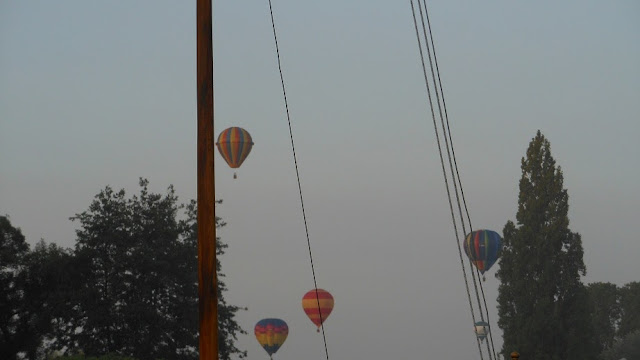During
our travels we have come to know the differences between many towns and cities
in France In our estimation some fare well, some not so well!
Dole
would be one of our favourite towns. It is difficult to define what makes it
so, probably nothing specific but all together we have grown to be very
comfortable in its environs. The town is the birthplace of Louis Pasteur in
1822 but can lay claim to little else of importance. He was the son of a tanner. The tannery was on a mill feed canal at the bottom of town and the
building is still there today. The canal still runs through the area which is
now very touristy with restaurants and gardens.
The
entrance to Dole along the Rhone-au-Rhin canal is leafy and very attractive.
On
this visit we chose to moor against this high-sided quay. The town provides us
with free electric power at this site.
Recently
the town was the gathering point of those huge things invented by the
Frenchmen, the Montgolfier brothers. Hot air balloons. For three days, morning
and evening up to as many as twenty of these magnificent (but sometimes quite
noisy) machines took off from the playing field nearby and soared away with the
drifting air in the most romantic fashion.
Amongst
them was this dramatic dirigible. An amazing balloon that had an engine and propeller
for propulsion as well as heating gas for elevation. Quite fun!
 During
our stay in Dole, we decided to see some of the surrounding area away from the
canal and river. We decided to take a train trip one day into the Jura ranges.
We travelled on the Lignes des
Hirondelles to St-Claude. All the pipe smokers amongst us know that
St-Claude was the centre of the manufacture of wooden pipes – for smoking
tobacco – in France. We are not too sure what keeps the town alive nowadays,
but that is not the point. Probably the fact that it is the diamond cutting center for France makes up for the loss of pipe smokers. Unfortunately they weren't handing out samples on the day we visited.
During
our stay in Dole, we decided to see some of the surrounding area away from the
canal and river. We decided to take a train trip one day into the Jura ranges.
We travelled on the Lignes des
Hirondelles to St-Claude. All the pipe smokers amongst us know that
St-Claude was the centre of the manufacture of wooden pipes – for smoking
tobacco – in France. We are not too sure what keeps the town alive nowadays,
but that is not the point. Probably the fact that it is the diamond cutting center for France makes up for the loss of pipe smokers. Unfortunately they weren't handing out samples on the day we visited.
The
following story could be said to be for train enthusiasts only but the scenery
that the rail line goes through is absolutely breathtaking and well worth the
trip.
The
town is serviced daily by this modern diesel – electric rail car. We departed
Dole about 1015 on the route to Pontarlier and Neufchatel. At the township of
Andelot en Montagne the train reverses direction and leaves the mainline onto a
little used side track. The line runs through heavily undulating country and
climbs steadily to a height of 903 metres near Morbier (of cheese fame) before
descending to Morez at 736 metres. The train then takes off backwards again and
runs mainly downhill to St Claude. The scenery in this area is exceptional and
the steepness of the hillsides has required some wonderful bridges and viaducts
as these pictures will show.
From
Morez to St Claude the line goes through many short tunnels and the rail
procedure in France is that the driver blows his whistle as the train enters
and leaves a tunnel.
Our
train of only one coach, had a large family group on board with a number of
children and the train driver left his cabin door open and invited some of the
children to assist him in sounding the horn. The train was only travelling at
about 30 to 40 kilometres per hour at this stage and with more than twenty
tunnels to go through, they all had a go.
After
the recent rail accidents in France Spain and Switzerland, this assistance may now be a
thing of the past.
An
interesting thing here for rail enthusiasts, shows in this picture of the rail
and points coming into St Claude station. You will notice the compressed gas
cylinders by the points. They have a system of heating the point blades in
winter to melt snow and ice that might get caught when the point is changed.
We
returned to Dole after a very enjoyable day and were back on Matilda early
evening.
There
will be other stories to share so we will keep in touch.


















































